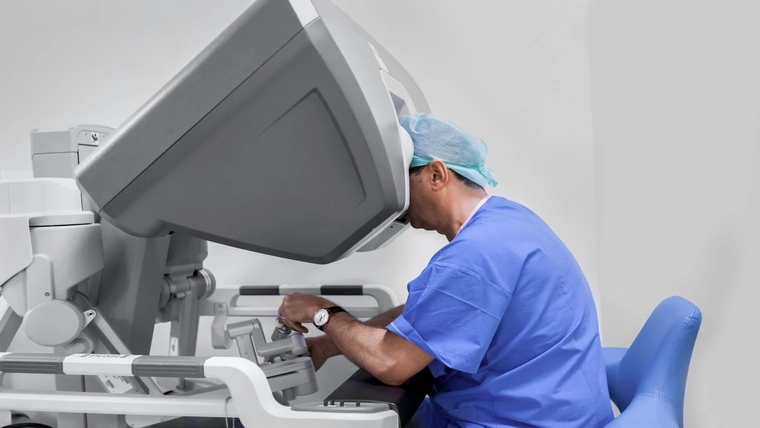
What is Robotic Chest Surgery and In Which Diseases is it Used?
Robotic thoracic surgery is a type of minimally invasive surgery used in some cases of lung cancer. Also known as robotic-assisted thoracic surgery, this method is used to remove diseased lung tissue and, if necessary, surrounding lymph nodes. During the surgery, the surgeon sits at a console next to the patient in the operating room and controls the instruments on the robotic surgical system. First, a small 3D high-resolution camera is inserted into one of the incisions to view the inside of the chest cavity. Then, robotic instruments are inserted through other small incisions made between the ribs. These instruments are completely controlled by the surgeon's hands on the console, and the surgeon removes the lung tissue through one of these incisions. Thanks to the magnified image and instruments that mimic wrist movements, the surgeon can remove the lung tissue with precise and controlled movements without making larger incisions or separating the ribs.
Besides lung cancer surgery, robotic technique can also be used in other types of thoracic surgery, including those on the lungs, esophagus, thymus and some heart surgeries.
What is Robotic Chest Surgery?
Robotic thoracic surgery is a surgical procedure in which surgeons use robotic systems to remove diseased tissue from the chest (thorax) area using a minimally invasive approach. The process begins with the patient being put under general anesthesia. Once the patient is asleep, a breathing tube is inserted, allowing each lung to be inflated separately during surgery. The patient is positioned on their side for the procedure, and the surgeon makes four small incisions, usually between the ribs. These incisions allow the surgeon to insert robotic arms and cameras into the chest area.
The surgeon sits at a nearby console to perform the surgery and sees magnified, clear images of the surgical field. The robotic system responds instantly to the surgeon’s hand movements and removes diseased lung tissue and lymph nodes if necessary. At the end of the surgery, the surgeon inserts a chest tube through one of the small incisions to drain fluid or air leaking into the chest cavity and help the lungs re-inflate. This tube is removed by the healthcare team as the patient recovers. Robotic thoracic surgery is a minimally invasive surgical procedure that often offers the advantages of shorter recovery times and earlier discharge from the hospital.
What are the advantages of robotic thoracic surgery?
Robotic thoracic surgery has many advantages over open thoracic surgery. Robotic instruments are extremely precise and maneuverable, allowing the surgeon to see clearly inside the chest during surgery. This allows the surgeon to easily access even hard-to-reach areas. Additionally, the advantages of minimally invasive surgery include less blood loss, faster recovery times, and a reduced risk of complications. These factors translate into shorter hospital stays and less discomfort for patients after surgery.
- Less Blood Loss: Since the surgery is performed with small incisions, blood loss is minimal.
- Fast Recovery Time: Thanks to the minimally invasive method, patients recover faster and can return to their daily lives more quickly.
- Less Risk of Complications: Small incisions and delicate surgical procedures reduce the risk of infection and other surgical complications.
- Shorter Hospital Stay: The length of time patients stay in the hospital after surgery is shorter than with traditional surgery.
- Advanced Imaging: The 3D high-resolution camera provides the surgeon with a clear and magnified view of the surgical site.
- High Maneuverability: Robotic instruments precisely mimic the surgeon's hand movements, making it easier to access hard-to-reach areas.
- Less Pain: Small incisions and delicate surgical procedures result in less post-operative pain.
What Are the Risks of Robotic Chest Surgery?
All surgeries, including robotic thoracic surgery, carry some risks. These risks can include blood clots, infection, bleeding, abnormal heart rhythms, air leaking from the lungs, and pain. Robotic thoracic surgery can also be associated with longer surgery times and a longer period of anesthesia. The surgeon may need to switch to a more invasive procedure if necessary to complete the surgery. Every patient responds differently to surgery, and surgical outcomes can vary depending on a variety of factors, including the patient’s health history, the type of lung cancer they have, the procedure being planned, and the surgeon’s experience.
What Diseases Is Robotic Chest Surgery Used In?
Robotic thoracic surgery can be used to treat a variety of thoracic diseases.
Among them:- Lung Cancer: Robotic surgery may be preferred in the surgical treatment of early stage lung cancer.
- Chest Wall Tumors: Used to remove benign or malignant tumors in the chest wall.
- Mediastinal Tumors: It can be applied in the treatment of mediastinal tumors located in the chest cavity.
- Lung Nodules: It can be used to remove lung nodules for diagnosis and treatment purposes.
Recovery Process After Robotic Chest Surgery
The recovery process after robotic thoracic surgery is usually faster. Patients experience less pain after surgery, use fewer analgesics, and can return to their daily activities sooner. The hospital stay is usually limited to a few days. However, the recovery process may vary depending on the patient's general health and the complexity of the surgery.
Who Can Receive Robotic Chest Surgery Treatment?
Robotic thoracic surgery is generally recommended for patients who are candidates for minimally invasive surgery. Patients with early-stage lung cancer, mediastinal tumors, or small lung nodules are particularly good candidates for this surgery. However, this treatment method may not be suitable for every patient, so it is important for patients to have a detailed evaluation with their surgeon.

